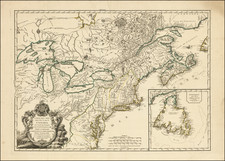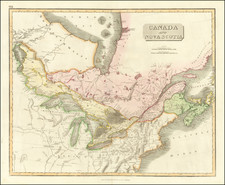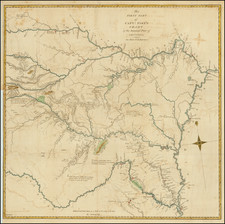"Without Serious Doubt . . . The Most Important Map In American History" (Lawrence Martin, Chief, Library of Congress Map Division, 1924-1946)
The final French & Indian War edition of John Mitchell's monumental map of North America, widely regarded as the single most important and influential map in American history.
First issued in 1755, John Mitchell's map holds a special place in American history as both a visual artifact which shaped American history and a central document in the treaties which defined the boundaries in the northern part of North America for the next 200+ years.
The present example is State 4 of the map, issued toward the beginning of the French & Indian War. State 1 and 2 of the map are generally considered to be proof states, with small errors that were immediately corrected by Mitchell, including the correction of the spelling of the printer's name (misspelled Miller in State 1) and the correction of the town name Leicester's to Worcester (two towns named Leicester appeared in State 2 in Massachusetts Bay Colony).
Mitchell refers to this state of the map as the "Second Edition" of the map. It was Mitchell,'s first set of revisions to the map and includes a marvelous commentary by Mitchell,, giving both an historic overview of the creation of the map and his contemporary thoughts and comments:
After the first drawing of this map in 1750, it was again corrected and improved, before it was published, and I have since taken Care to procure & examine all the information I could get, in order to render it as correct & usefull as possible; which has given occasion to this Second Edition of it, in which I have likewise inserted all the Observations I believe we have for the Geography of N. America, since I find them grossly misrepresented by others.
The Foundation of this Map is the several Manuscript Maps, Charts & Surveys that have been lately made of our Colonies, which represent most Places from the Ocean to the Missisipi. But in order to know the true Situation of those Places, we must have their Latitudes & Longitudes, which are of more Consequence in a general Map, than their bare Shape or Figure, which we only find represented in our Draughts & Surveys. But after having consulted all the Observations I believe that we have, I found the true Situation, or Latitude & Longitude, of many Places was undetermined or uncertain; & that we had no Accounts of them, but what might be found in the Journals of our Ships of War kept in the Admiralty Office; which I had Recourse to for that reason, and have extracted from them whatever relates to our purpose, which are the Chief Source of the Corrections & observations here inserted.
Since the Publication of this Map likewise I have examined & compared with other Accounts, the Observations of Mr. Chabert; which were not made when our Map was first drawn, nor known in England till after it was published; so that we neither followed nor rejected them.
Mitchell's text continues for two additional columns. First, he addresses in two sections delineated in Roman numerals the major changes to the map and their source:
- I. Cape Race: Mitchell, discusses the prior surveys of Lieutenant John Gaudy (1716) and Captain Thomas Durrell (1716-18), the observations of Chabert, Bellin and British War ships, before explaining his correction to the location of Cape Race.
- II. Cape Sable: Mitchell, discusses again the change resulting from the comparison of the survey of Durrell and Chabert and "our [British War] ships."
Part III of Mitchell's text serves two purposes. The longer portion is dedicated to an evaluation of the accuracy of other contemporary maps, much of which is less than complimentary. In summary, he states:
The Map of New England & Nova Scotia requires a farther Consideration, as we find them very erroneously laid down . . . especially our many New Maps copyed from a New Map of Nova Scotia, copyed from Popple and 'd'Anville; and those Errors are maintained by Arguments & pretend authorities, which seem to have confirmed them.
The only Authority they have for all this is, a feigned Survey by pretended Surveyor General Blackmore in 1711-12, who appear by his Journals to have been Lieutenant of the Dragon Man of War 1711, and made a rude Draught of this Coast (as well as he remembered it perhaps) in 1715, with a Petition to the Board of Trade to enable him to Survey it at that time, which he never did as we can learn. But this Draught, falling into the Hands of some Workmen, Mr. Moll published it as an Actual Survey "made by her Majesties especial command" from which this coast has been thus erroneously laid down ever since.
Following a lengthy explanation of his comparative observations, Mitchell reaches a conclusion and introduces what he likely believed to be the most important contribution in this "Second Edition" of his map, the extensive observations which Mitchell had meticulously compiled at the bottom of the map.
In short we do not find a single spot hardly justly laid down in these our New Maps of Nova Scotia, altho. they were rightly laid down formerly by de L'Isle & others. We are so far from improving then in the Geography of America that we see it made worse & worse for want of certain Observations, which we have endeavored to collect & thus to represent in one view.
For his observations, Mitchell sets forth in 7 columns a series of different types of observations. For each, Mitchell also includes his sources, a remarkably detailed amalgamation of the best available scientific observations of the time. Mitchell organizes these observations in 7 primary parts as follows:
- I Astronomical Observations
- II Latitudes Observed
- III Latitudes Observed; Extracted from the Journals of our Ships of War
- IV Longitudes of the Coast From Reckonings of our Ships of War
- V Latitudes and Longitude Calculated from Bearings & Distances, Observed in our Ships of War
- VI Latitudes & Longitudes Deduced From Surveys & Mensuration of Distances
Map Overview
Mitchell's Map of the British and French Dominions in North America . . . is widely regarded as the most important map in American History. Prepared on the eve of the French & Indian War, it was the second large format map of North America printed by the British, and included the best up to date information of the region. Over the next 200 years, it would play a significant role in the resolution of every significant boundary dispute involving the northern border of the then British Colonies, and later the United States. It was also the map-of-record at the birth of the United States and continued in this role through the early life of the country.
As noted by Benjamin Franklin in his April 9, 1790 letter to Thomas Jefferson, Mitchell's map was the central reference point in negotiating boundaries between the Britain and the newly independent United States under the Treaty of Paris in 1783.
I can now assure you that I am perfectly clear in the Remembrance that the Map we used in tracing the Boundary was brought to the Treaty by the Commissioners of England, and that it was the same that was published by Mitchell about 20 years before."
Thomas Jefferson recommended that Nicholas King use Mitchell's map in preparing a new map for Meriwether Lewis prior to the Lewis & Clark expedition, saying: "it was made with great care we know from what is laid down in those western parts with which we have lately become acquainted."
Lawrence Martin, the second chief of the Library of Congress Geography and Map Division provided the following partial list of important uses of Mitchell's map:
1. [Mitchell's map] is thought to have been in use in the British House of Commons during the debate on the Quebec Act of 1774
2. It is known to have hung in the halls of Congress in 1802 and several times subsequently.
3. It was used ... in the discussions of British land grants in the Ohio and Mississippi valleys, and in scores of controversies involving the boundary lines existing at the time of its publication.
4. Great Britain and the United States agreed to its official status in the Convention of September 29, 1827....
5. It exerted substantial influence in the negotiation and ratification of the Webster-Ashburton Treaty of 1842,.
6. Serious argument was based upon it by Great Britain before the Court of Arbitration at The Hague in 1910 in connection with the North Atlantic Coast Fisheries Arbitration.
7. It was submitted in evidence before the Law Lords of the British Privy Council in 1926 in the appeal of Price Brothers & Company, Limited, from a judgment of the supreme court of Canada, and in 1926-27 in the Canada-Newfoundland (Labrador) boundary case.
8. It was used as evidence before the Supreme Court of the United States in the Wisconsin-Michigan boundary case, in 1926-27 in the Great Lakes level case, and in 1932 in the New Jersey-Delaware boundary case."
[numbering and paragraph breaks added]
John Mitchell
John Mitchell (1711-1768), a respected British physician, botanist, chemist, biologist, and surveyor, lived for a time in Virginia, but returned to England in 1746, where he remained until his death. Mitchell initially conceived of his map of North America in order to present the British public with a single large format image of all the colonies, in order to illustrate the extent of the French threat to the British claims in North America. Mitchell completed his first draft of the map in 1750. However, because Mitchell was limited to publicly available sources of information, this initial effort was rather crude, even in Mitchell's own opinion. As word of Mitchell's work spread, the Board of Trade and Plantations retained Mitchell to make a new map, using the official manuscript and printed maps and reports in the Board's possession, including maps by Fry and Jefferson, Christopher Gist, George Washington, John Barnwell, and others. The Board also instructed all colonial governors to send detailed maps and boundary information for Mitchell's use.
Publication History
Mitchell's map was first published by Andrew Millar in 1755, one year before the start of the French & Indian War (Seven Years War). The map is decidedly pro-English in its interpretation of the various boundaries and geographical information depicted on the map, as would be expected for what amounted to thinly British propaganda. In addition to the geographical detail shown on the map, Mitchell included many annotations describing the extent of British and French settlements. He also submitted a report to the Board in 1752, listing the French encroachments and his ideas to encourage British settlement west of the Appalachian Mountains, as a means of combating French influence in the region. Mitchell is also the likely author of The Contest in America Between Great Britain and France by an Impartial Hand (1756), which addresses the same topic.
The first edition of the map was quickly followed by a second edition in 1757, which adds two large blocks of text in the Atlantic Ocean, providing Mitchell's data sources and an account of how he compiled the numerous provincial maps to create this map. After Mitchell's death in 1768, the plates were purchased by Jefferys & Faden, who revised the map and issued a third edition in 1773-74. Faden published a fourth edition in 1775, with the title changed to A Map of the British Colonies in North America ....
The Map
Mitchell's map shows the British Colonial claims of Virginia, both Carolinas, and Georgia extending beyond the Mississippi to the Pacific Ocean.
In the West, Mitchell's treatment of the lower Missouri is a vast improvement over earlier maps. Regarding the source of the Missouri, Mitchell notes "Missouri river is reckoned to run westward to the Mountains of New Mexico, as far as the Ohio does eastward," reflecting his belief in symmetrical geography. Mitchell correctly shows the northern branch of the Missouri to be the main branch of the river, although his estimate of the latitude of the river's source is inaccurate. Nonetheless, the information Mitchell's map provided led Meriwether Lewis up the Marias River to determine the northern reaches of the Missouri River basin.
Ristow noted twenty-one variant states and editions of the map appeared between 1755 and 1781 (7 English; 2 Dutch (Covens & Mortier); 10 French (Le Rouge) and 2 Italian (Zatta)) John Jay used a copy of the third edition during the negotiations of what would become the Treaty of Paris (1783).
States of the Original English Edition of Mitchell's Map
The present example is State 4 of the map, with the added text panels at the bottom right.
- State 1 (1755): Publisher's name spelled "Miller" (not Millar). Publisher's street name spelled "Katherine" (not Katharine).
- State 2 (1755): Publisher's name correctly spelled Millar. Publisher's street name corrected spelled Katharine.
- State 3 (1755): First two states include the town name Leicester in Massachusetts twice. This state corrects one of the Leicester's to Worcester.
- State 4 (1755-1757): Text panels in the Atlantic added. Scale of miles now above the cartouche.
- State 5 (circa 1773): Millar's name deleted. Jefferys and Faden imprint added.
- State 6 (circa 1774): Printed boundary added in the middle of Lake Ontario.
- State 7 (circa 1775): Title changed to "A Map of the British Colonies in North America . . . "
Rarity
All states of the Mitchell are rare on the market. We note only a single example of this state of the map at auctions reported in RareBookHub over the past 50 years.
David Rumsey "believe[d] the second edition is scarcer than the other editions as it appears less often on the market."
Provenance: Private American Collection. Previously sold by this firm to the owner 2003.













![[ Mexican Railroads ] Carta De Comunicaciones De Los Estados Unidos Mexicanos Formada de orden de la Secretaria de Estado y del Despacho de Comunicaciones y Obras Publicas, por el Coronel Bodo von Glumer . . . Primera Hoja. 1895 - 1896. (and) Segunda Hoja 1895 - 1896](https://storage.googleapis.com/raremaps/img/small/103235.jpg)
![Johnson's North America [with Inset of Hawaii]](https://storage.googleapis.com/raremaps/img/small/88883.jpg)